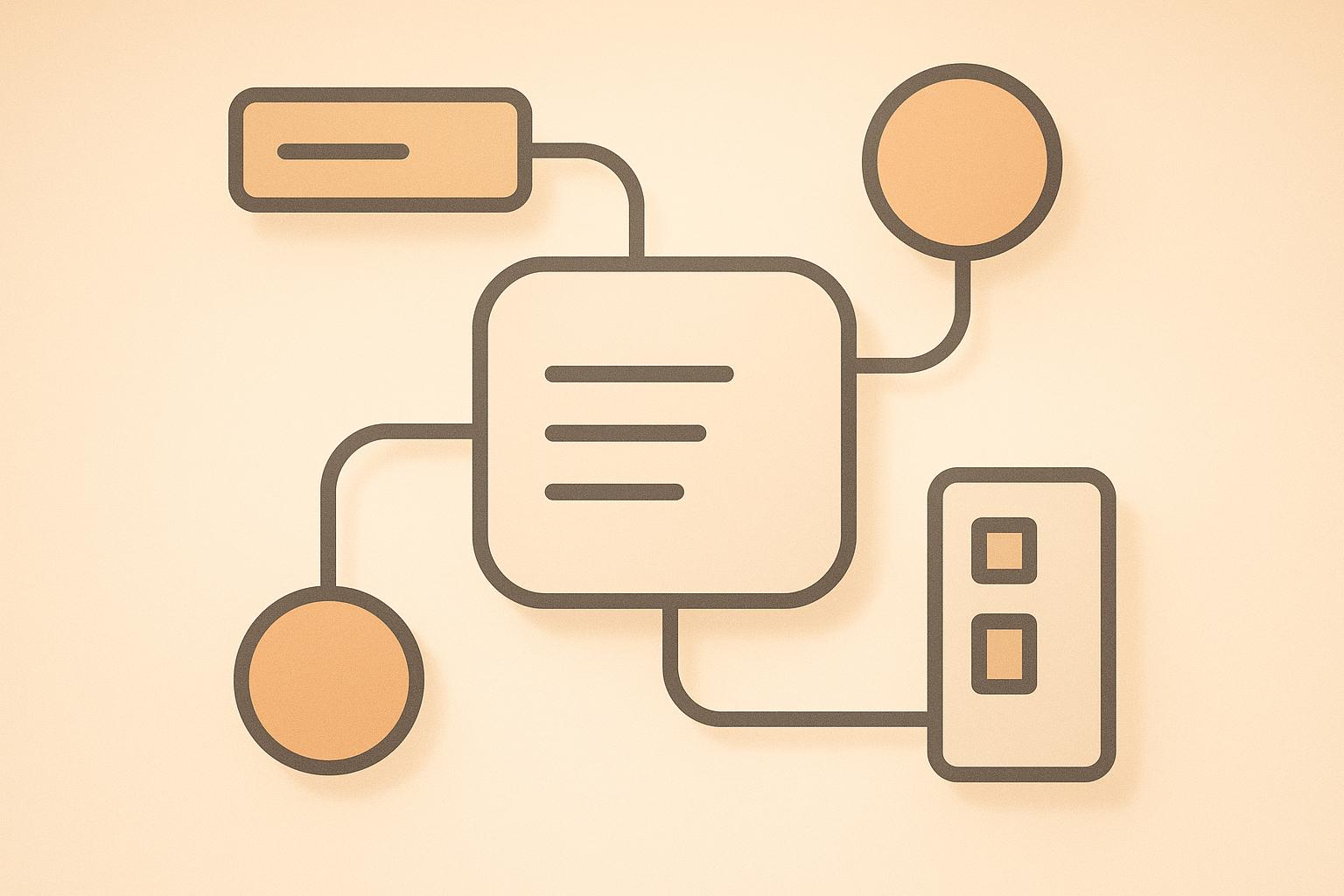
.avif)
Julien Gadea
Julien Gadea specializes in AI prospecting solutions for business growth. Empowering businesses to connect with their audience with SalesMind AI tools that automate your sales funnel, starting from lead generation.
Predictive analytics transforms lead scoring by using historical data and machine learning to identify high-potential prospects. Unlike basic point systems, it evaluates complex patterns across multiple data sources like CRM systems, email engagement, and online behavior. This approach allows sales teams to focus on leads most likely to convert, improving efficiency and revenue outcomes.
Key Takeaways:
- Predictive analytics analyzes historical data to improve lead scoring accuracy.
- It integrates data from CRM, marketing metrics, website analytics, and third-party sources.
- Machine learning algorithms like logistic regression and neural networks refine scoring.
- Scores evolve dynamically based on new interactions, ensuring up-to-date prioritization.
- Sales tools like CRMs integrate predictive scores for better team workflows.
How Do Predictive Lead Scoring Models Work? - Sales Saas Breakdown
How Predictive Analytics Works in Lead Scoring
To grasp why predictive analytics often outshines traditional lead scoring, it's helpful to understand how it works. The process involves gathering diverse data, training advanced algorithms, and producing actionable scores that guide your sales team's priorities. Below, we’ll break down the key data sources, machine learning techniques, and scoring methods that fuel these insights.
Key Data Sources for Predictive Lead Scoring
Predictive models thrive on a mix of high-quality data collected from various sales and marketing interactions. The better your data, the more accurate your predictions.
- CRM Systems: These provide a treasure trove of historical customer data, including deal outcomes, sales cycles, revenue figures, and firmographic details (like company size or industry). This helps the model identify patterns associated with successful conversions.
- Marketing Automation Metrics: Data like email open rates, click-through rates, content downloads, and webinar participation reveal a prospect's level of interest and intent to buy.
- Website Analytics: Tracking visitor behavior - such as page views, time spent on pricing pages, or repeat visits - offers insights into how serious a prospect might be about your product or service.
- Social Media and LinkedIn Activity: Professional movements, such as job changes, company growth, or hiring trends, can signal the right moment to reach out.
- Third-Party Data: External signals, like funding announcements or technology adoption trends, add valuable context to your internal data, helping pinpoint when engagement could be most effective.
The real magic happens when all these data points are integrated. By analyzing relationships between behaviors, the model can identify prospects showing multiple strong indicators, which often signals a much higher likelihood of conversion compared to those with just one or two.
The Role of Machine Learning Models
Once the data is gathered and organized, machine learning algorithms step in to uncover patterns and refine lead scoring. They’re particularly good at spotting trends and relationships that would be nearly impossible to detect manually. Different algorithms bring unique strengths to the table:
- Logistic Regression: This method estimates the likelihood of conversion based on factors like firmographics and behavior.
- Decision Trees and Random Forests: Decision trees follow logical paths to determine lead quality, while random forests combine multiple trees for greater accuracy.
- Neural Networks: These excel at identifying subtle, non-linear patterns, such as how specific combinations of engagement behaviors and job roles might predict a higher conversion rate.
The learning process involves feeding these algorithms historical data - both from successful deals and missed opportunities. Over time, the model becomes better at identifying the factors most closely tied to success. Regular retraining ensures the model stays relevant as buyer behaviors and market conditions shift.
Feature engineering, a critical step, refines the data further. For example, instead of just tracking how many emails a prospect opens, you could create an "engagement velocity" metric that measures how quickly a lead responds to outreach. This kind of transformation helps the model capture more meaningful patterns.
Understanding Predictive Scores
Predictive scores distill complex algorithmic outputs into actionable insights for sales teams. These scores, often expressed as percentages or grades, represent the likelihood of a lead converting.
To make the most of these scores, it’s important to understand both the numbers and their context. High scores typically indicate leads with a strong history of converting, making them top priorities for outreach. Scores often guide specific actions:
- High Scores: These leads might warrant immediate follow-ups, such as a phone call or meeting request.
- Moderate Scores: These could trigger personalized email campaigns or other nurturing efforts.
- Low Scores: These leads are often placed in long-term nurturing workflows until their engagement improves.
Dynamic scoring ensures that a lead’s score evolves as new actions are taken. For example, attending a product demo or revisiting key web pages might boost a lead’s score, ensuring your team always works with the most current information.
Thresholds can also be set to filter out less promising leads. For instance, if your sales team has limited capacity, you might only focus on leads above a certain score. Some systems even provide transparency by showing which factors influenced a lead’s score the most. This helps sales reps tailor their outreach, addressing the specific needs or interests of each prospect.
Ultimately, predictive scores are a tool - not a rulebook. The best sales teams use these insights to guide personalized strategies, combining data-driven decisions with a thoughtful, human approach. These scores are just the starting point for building meaningful connections that turn leads into customers.
Steps to Implement Predictive Lead Scoring
To make predictive lead scoring work effectively, you need a clear plan. This involves setting goals, preparing reliable data, building and testing models, and integrating the system with your sales tools. Here’s how to get started:
1. Define Goals and Success Metrics
Before diving into the data, decide what success looks like for your business. Are you aiming to increase conversions by 25%? Or maybe you want to cut your sales cycle from 45 to 30 days? Each goal will shape how you approach predictive scoring.
Your metrics should align with your sales process. Common ones include improving conversion rates, shortening sales cycles, increasing revenue per lead, and enhancing sales team efficiency. Look at both leading indicators (like engagement levels) and lagging ones (like closed deals) to get a full picture of your performance.
2. Prepare and Consolidate Data
Your predictive model is only as good as the data it’s built on, so data preparation is crucial. In fact, 42% of business and technology decision-makers cite poor-quality data as the biggest hurdle to adopting AI [2].
Start with a data audit to identify gaps, inconsistencies, and duplicates across your systems. Then move on to data cleaning: remove duplicate entries, standardize naming conventions, and fix errors like invalid email addresses or dates.
If you have missing data, handle it carefully. For small gaps, deletion might be fine. For larger issues, use methods like filling in median values or predictive techniques to estimate the missing information [1][4].
Next, consolidate your cleaned data into a centralized location, such as a data warehouse or analytics platform, where it can be securely managed and accessed for model training [3]. Standardize formats across all systems - for example, if one system categorizes company size as "Small/Medium/Large" and another uses employee numbers, create a consistent format. This avoids confusion and ensures the model can make accurate predictions.
3. Train and Test Models
Once your data is ready, train predictive models using historical data to identify patterns that signal high-quality leads.
Divide your data into training and testing sets - about 70-80% for training and 20-30% for testing. Start with simpler algorithms like logistic regression. These are easier to interpret and often provide strong results. As you refine your process, explore more advanced techniques like random forests or neural networks.
Feature engineering is key to improving model performance. Instead of relying solely on raw data, create meaningful metrics. For example, calculate how quickly prospects respond to outreach (engagement velocity) or combine behavioral indicators into a composite score.
Assess your model using metrics like accuracy, precision, and recall. Accuracy measures overall correctness, precision evaluates how many high-scoring leads actually convert, and recall checks how well the model identifies all convertible leads. Depending on your goals, you may prioritize precision over recall if your team has limited capacity to handle leads.
4. Connect with Sales Tools
A predictive model is only useful if it integrates seamlessly with your sales tools and workflows.
Start with CRM integration. Predictive scores should be visible within your CRM, alongside other lead details. This could mean adding custom fields for scores, automating tasks for high-scoring leads, or setting up alerts for significant score changes.
Tools like SalesMind AI can take this further by incorporating predictive scores into LinkedIn outreach and lead qualification. For example, when a high-value lead is identified, the system can trigger personalized messages, prioritize follow-ups, and assign leads to the right sales reps.
Set up automated workflows to act on score changes in real-time. If a lead’s score increases due to engagement, notify the assigned rep or move the lead into a high-priority sequence. Leads with declining scores can be shifted to nurturing campaigns instead of direct outreach.
Use score-based routing rules to assign leads to the right team members. For instance, high-scoring enterprise leads might go to senior account executives, while moderate-scoring ones are handled by inside sales reps. This ensures your team’s time is used efficiently.
Finally, establish feedback loops between your sales team and the predictive model. When reps mark leads as qualified or unqualified, this data should feed back into the model to improve its accuracy. Regular updates help the system adapt to real-world changes.
Dashboards and reporting tools are also important. These give sales managers insights into how predictive scoring is impacting performance. Track metrics like conversion rates for different score ranges, time-to-close for high-scoring leads, and overall improvements since implementing the system. This visibility helps refine strategies and keeps the team aligned.
sbb-itb-817c6a5
Benefits of Predictive Lead Scoring
Predictive lead scoring shifts sales strategies from guesswork to precision, using historical data to identify patterns in both successful and unsuccessful leads. By pinpointing traits associated with conversions, it enables sales teams to zero in on prospects with genuine buying potential.
Better Lead Prioritization
Say goodbye to intuition-driven decisions. Predictive lead scoring provides clear, data-backed insights to rank prospects effectively. This prioritization not only ensures that the most promising leads get the attention they deserve but also streamlines lead distribution across the team, boosting overall efficiency.
Improved Sales Efficiency
When sales teams focus their energy on high-potential prospects, they operate more effectively. By minimizing time spent on leads less likely to convert, sales reps can dedicate their efforts to meaningful interactions, driving better results.
Automated Sales Tool Integration
The power of predictive lead scoring multiplies when it integrates with existing sales tools. For example, CRM systems can display lead scores alongside other critical data, giving sales reps a comprehensive view of opportunities. Automated workflows can then take over, triggering tasks like follow-ups or notifications whenever lead scores change.
Take SalesMind AI, for instance. It embeds predictive scores directly into LinkedIn outreach and lead qualification processes. With features like an AI-powered unified inbox and automated follow-ups, SalesMind AI ensures timely, personalized engagement with high-value leads. On top of that, feedback from sales activities helps refine future scoring, making predictions even sharper over time.
Maintaining and Updating Predictive Models
Predictive models aren't a "set it and forget it" solution. They need regular updates to keep pace with shifting market conditions, evolving customer behavior, and changing business goals. Without these updates, even the most advanced models can deliver outdated insights, potentially steering your sales team in the wrong direction. To keep predictive lead scoring accurate and actionable, maintaining model performance is essential.
The data that shaped your model six months ago may no longer reflect the current market landscape. Competitors emerge, economic factors fluctuate, and buyer preferences evolve. For your predictive model to stay relevant, it must adapt to these changes.
Monitoring Model Performance
Tracking your model's performance begins with establishing baseline metrics when it first launches. Key indicators include conversion rates, lead-to-customer ratios, and the AUC-ROC score, which measures how well your model differentiates between leads.
Automated alerts are a must-have for catching performance dips. For example, a strong predictive model typically has an AUC-ROC score above 0.7, with anything over 0.8 being excellent. If that score falls below 0.65, it’s a clear signal that your model needs immediate attention.
Keep an eye on how predicted outcomes align with actual results. For instance, if your model predicts a 25% conversion rate for leads scoring above 80, but the actual conversion rate is only 15%, it’s time to recalibrate. Initially, track these metrics weekly, then move to monthly once the model stabilizes.
Another sign of trouble is a skewed lead distribution. If your model starts scoring most leads either very high or very low, it could mean it's overfitting to recent data or missing critical patterns. A healthy model should distribute scores across a wide range, ensuring a balanced pipeline for your sales team.
When you spot performance drops, the next step is clear: update your data and retrain the model.
Updating Data and Retraining Models
Aim to retrain your models every 90 days - or sooner if performance issues arise. Fresh data is essential, including recent lead interactions, updated demographic details, and new behavioral signals from your website and marketing campaigns.
Start by auditing your data sources. Outdated or irrelevant data can drag down performance, so clean up your datasets to ensure they reflect current market realities.
Using incremental learning methods can help. This approach integrates new data while preserving valuable historical insights, cutting down on training time and keeping the model stable.
Seasonality is another factor to consider. For example, B2B buying often follows predictable cycles, with slower activity during holidays and spikes at fiscal year-ends. Your model should account for these patterns to avoid mistaking temporary trends for permanent shifts.
Before deploying an updated model, test it against historical data through backtesting. This ensures it outperforms the previous version across different scenarios. Only roll out models that consistently demonstrate improvement.
Once your updated model is live, revisit your scoring thresholds to align them with your current business goals.
Adjusting Scoring Thresholds
Scoring thresholds dictate which leads your sales team prioritizes. These thresholds need to evolve alongside your business objectives. For example, what qualified as a high-priority lead last quarter might not fit your current strategy.
Adjust thresholds based on feedback from your sales team and your shifting goals. If your focus moves from lead volume to lead quality, raise the threshold for high-priority leads. On the other hand, if you're entering a new market, lowering thresholds might help capture more prospects while your model learns about this new audience.
If your team notices that leads scoring between 70 and 80 are converting better than expected, consider lowering the high-priority threshold. Regular feedback sessions with your sales reps can help fine-tune these settings to match real-world results.
A/B testing is another effective way to optimize thresholds. Run campaigns with different scoring cutoffs and compare the results to determine which approach works best. This removes the guesswork from decision-making.
After adjusting thresholds, monitor how lead volumes shift. A sudden surge or drop in high-priority leads can overwhelm or underutilize your sales team. The goal is to strike a balance: manageable lead volumes that also improve overall quality.
Platforms like SalesMind AI make this process easier by automatically tracking performance metrics and highlighting optimization opportunities. With its unified dashboard, you can monitor conversion rates, score distributions, and performance trends at a glance. Automated workflows can even trigger retraining when performance dips, ensuring your lead scoring stays sharp without requiring constant manual intervention.
Conclusion: Transforming Sales with Predictive Analytics
Predictive analytics is reshaping lead scoring, giving sales teams the tools to pinpoint high-value prospects with accuracy. This shift not only boosts conversion rates but also enhances overall efficiency, allowing sales professionals to focus on what they do best - nurturing relationships and closing deals - rather than wasting time on unqualified leads.
By replacing guesswork with data-driven decisions, this approach empowers teams to work smarter. Instead of relying on intuition or basic demographic data, predictive models analyze hundreds of variables at once. These algorithms uncover patterns and insights that might otherwise go unnoticed, enabling smarter decisions throughout the sales funnel. The result? A more refined strategy that drives continuous improvement and steady growth.
Success hinges on ongoing refinement. Predictive models aren’t a "set it and forget it" solution - they require regular updates, performance checks, and fine-tuning to stay effective. Organizations committed to treating predictive analytics as an evolving process tend to see the best results over time.
SalesMind AI demonstrates how predictive analytics can streamline workflows. By integrating scoring algorithms with automated outreach tools and unified communication systems, the sales process becomes smoother and more effective from start to finish.
As markets shift and buyer behaviors change, predictive analytics will only grow in importance. Sales teams that adopt this technology now are setting themselves up for long-term success, while those clinging to outdated methods risk falling behind competitors who leverage data to sharpen their edge.
The future of sales lies in combining human expertise with predictive technology, creating a powerful partnership that delivers consistent, measurable outcomes.
FAQs
What makes predictive analytics different from traditional lead scoring, and how does it benefit sales teams?
Predictive analytics takes lead scoring to a whole new level by leveraging machine learning and large-scale data analysis to identify leads with the highest potential. Instead of relying on static, rule-based systems, it adjusts to evolving patterns and trends, providing more precise and flexible scoring.
For sales teams, this means higher conversion rates, faster sales cycles, and better coordination with marketing. By automating lead prioritization, it cuts down on manual work, allowing teams to concentrate on the most promising opportunities - making the entire sales process more efficient.
What data is crucial for creating a successful predictive lead scoring model?
To create a solid predictive lead scoring model, you’ll need a mix of different types of data:
- Behavioral data: Tracks actions like website visits and email interactions.
- Demographic data: Includes details such as age and location.
- Firmographic data: Covers company-specific information like size and industry.
- Historical interaction data: Pulled from your CRM and marketing tools to understand past engagement.
By analyzing these data points, you can spot trends and anticipate which leads are most likely to convert. This not only boosts sales efficiency but also ensures your outreach efforts are more precise and impactful.
How can sales teams keep predictive lead scoring models accurate and effective over time?
To keep predictive lead scoring models sharp and reliable, sales teams need to prioritize regular data updates and cleaning. This ensures the models stay aligned with current trends and shifting customer behaviors. By closely monitoring how the models perform and using insights from real-world interactions, teams can pinpoint areas that need adjustment.
Another key step is retraining the models with updated data. This helps them adapt to changes in the market and maintain their accuracy. Running tests with validation datasets is also a smart move, as it ensures the models continue to produce dependable results, keeping your lead scoring process relevant as your business grows and evolves.




